How Much Money Do Professional Badminton Players Make?
From a financial perspective, having a career in professional badminton can be incredibly rewarding. However, how much money a player can earn will hugely differ as it depends on their ranking, the event they play, funding situation, and also their marketability!
So whether you’re a parent or player making decisions about a potential career in badminton, or you’re just simply curious, we’re going to give an insight into how much professional badminton players make, from the top 100 in the world, to the world number 1!
We’ll be splitting this into different ranking categories and go through all the different ways players make money, how much they make and also how much they might spend!
Please note: All the information we discuss is based on research we did for the year 2022 and does not include December 2022. We also stick to US Dollars when discussing the numbers!
Table of Contents
What Are The Different Income Streams Of A Badminton Player?
For each of the ranking groups below, we’ll cover the 4 main income streams that a professional badminton player usually has:
- Prize money – money received from achieving certain results in tournaments
- Club money – money received from representing a club in national badminton leagues
- Sponsorships – money received from a company or organisation (often in exchange for promoting their products)
- Part-time jobs – this can be anything from coaching to stringing to working in a supermarket!
Badminton Players Ranked 51-100 In The World
We’re going to start with players ranked from 51-100 in the world, as unfortunately if you’re below 100 you don’t make much money at all!
And for context, the 100th best male footballer in the world (according to The Guardian) is Pierre-Emile Hojbjerg who earns $6.5 million a year – just in wages.
And the 100th best women’s tennis player in the world is Anna Schmiedlova who earnt over $510,000 in 2023 – just in prize money!
Prize Money
We’ve taken the average prize money earned from players ranked 51-100 in all 5 events and this was $2053 a year.
At this level, doubles and singles work out very similar despite doubles players getting less prize money per tournament (as doubles players have to share prize money with their partner!).
The highest earning players in this category were women’s doubles pair Ng and Tsang, who each earned $20,676 in 2022.
Club Money
We’re mainly talking about the European leagues here, but we’ll get onto the big money leagues like the Indian Premier League later on!
We’ve personally played in 5 leagues across Europe for the last 9 years and can say that most players between 51 and 100 in the world can expect around $300-500 per match.
And at this level, most players do play in a club, and sometimes more than 1 club!
So let’s say a player plays 12 matches a year which is about average, that’s a minimum of $3600 and a maximum of $6000. This is usually all profit because clubs typically pay for your travel, accommodation and food too!
Part-Time Jobs
We’ve both had our fair share of these over the last 10 years and the income can range from as little as $0 (if you don’t have one) to $10,000 a year depending on what the job is and how many hours you work. This can of course be even more if you have a very good job or a successful business!
Whilst having a part-time job might be necessary, it’s definitely not ideal to be working too many hours whilst also trying to become the best badminton player you can be!
Sponsorships
A badminton player ranked 51-100 should expect anywhere from $0 to $10,000 a year in sponsorships. The higher range would generally be if someone came from a country with minimal sporting success, has negotiated very well, has a connection to a successful business, or is very marketable for one reason or another!
You can also get financial support for various things such as studying which is the route we and many others go down, or for being in the army in countries like Germany or Singapore.
Total For Players Ranked 51-100
So, based on these figures badminton players ranked between 51-100 in the world earn a minimum income of $5,653 per year and a maximum of $28,053 per year. This is not all profit though – far from it actually, but we’ll get onto the expenses later in the article.
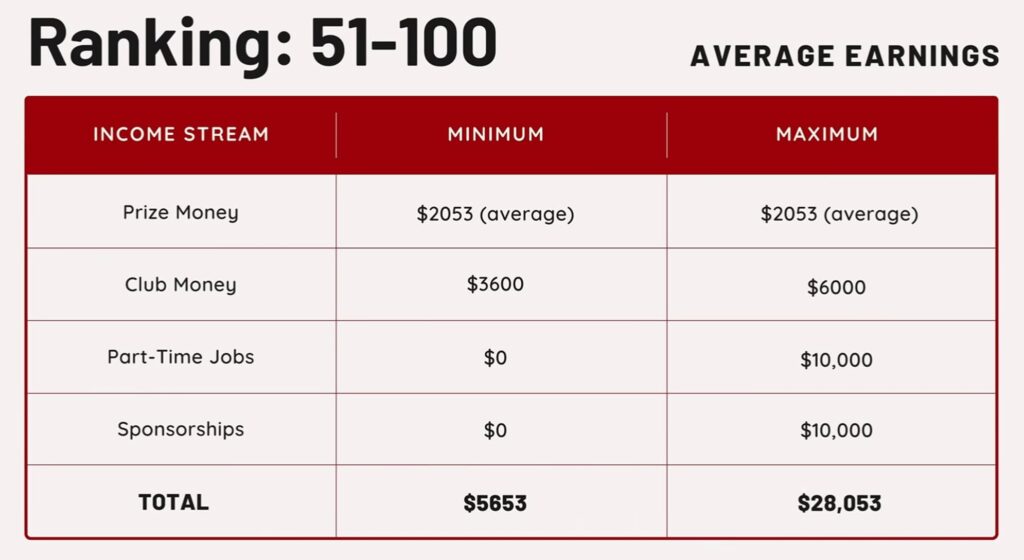
Badminton Players Ranked 33-50 In The World
Prize Money
The average prize money for players in this range is $8159 a year for singles players, and $6481 for doubles players.
The highest earner in this category was Jeong Na Eun, who was ranked 34 in mixed doubles and earned $77,293. She was also ranked 5 in the world in women’s doubles which will contribute to a lot of this prize money – hence why the amount you earn can depend on how many events you play!
Club Money
For this, you’re looking at anywhere between $400 and $1300 per match. Of course the exact rate will depend on the player, for example a very good women’s singles player who can also play doubles is often very sought after in the European leagues!
So again using an average of 12 matches, that’s a minimum of $4800 and a maximum of $15,600.
Part-Time Jobs
As players climb higher in the rankings you’d expect them to do less part-time jobs because they get more money from other revenue streams. But because financial support really varies from country to country, we will keep this at a minimum of $0 and a maximum of $10,000.
Sponsorships
Sponsorships in this range can expect to bring in a minimum of $0 a year and a maximum of $10,000 a year… But again this all depends on your results and marketability!
Total For Players Ranked 33-50
So in total, being ranked 33-50 in the world you can expect a minimum income of $12,959 per year if you’re a singles player or $11,281 if you’re a doubles player, and a maximum of $43,759 for singles and $42,081 for doubles.
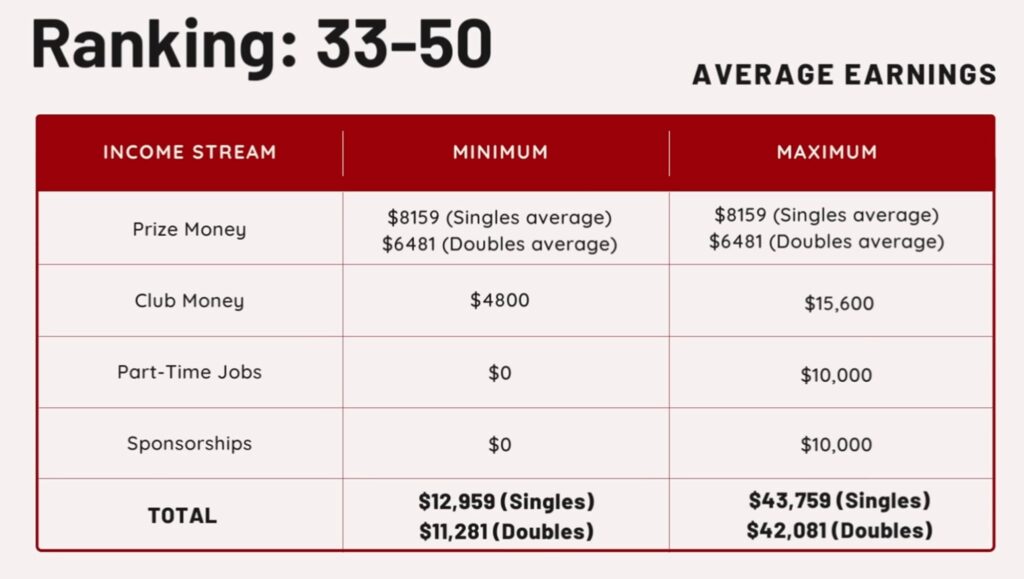
Badminton Players Ranked 11-32 In The World
Being ranked in the top 32 is very significant because it means you’re pretty much guaranteed entry into all of the big tournaments, which has big implications on the money you can earn! We’re also going to assume that people in this range no longer need part time jobs too, so we’ve left that section out!
Prize Money
Bigger events means higher prize money! For example, in the Super 1000’s you can lose in the first round and you still get a nice $1200!

Again for some context, this is very small compared to tennis as reaching the last 32 in Wimbledon in men’s singles gets you a huge $181,001. That’s double the amount than WINNING the All England (which is $91,000 for singles)!
So, the average prize money for players ranked 11-32 is $25,275 for singles players, and $15,498 for doubles players.
The highest earner in this ranking range in 2022 was Shi Yu Qi from China, earning a very nice $77,175 in 2022 (playing only 6 tournaments)!
Club Money
Generally these players won’t be playing as many club matches, but when they do their rate will be a lot higher! Here we’ll reduce the average number of matches to 8 but increase the rate to between $600 and $2000 per match.
However, we have yet to mention other leagues outside of the European leagues, such as the Indian Premier Badminton League (PBL) or the Malaysian Purple League. Rather than running over many months, these leagues happen over a few weeks and can be very lucrative for some players!
For example, in the PBL in India in 2019, Lee Cheuk Yiu got around $61,000 for the 3 weeks and he was ranked 28 in the world at the time.
This gives us a minimum of $4800 per year and a maximum of $77,000 (assuming you play in the PBL which has actually not happened in 2023 and 2024)!
Sponsorships
As well as getting into the big tournaments, being in the top 32 will also mean get more recognition from big badminton brands such as Victor or Yonex, and from other sponsors too, since players will have more media exposure.
Of course we don’t know actual figures as players contracts aren’t public, but we’d estimate anywhere between $4,000 if you’re around the 32 ranking, up to $50,000 per year if you’re around 11 in the world. However this can be higher if a player has multiple sponsors and is very marketable in their country.
Total For Players Ranked 11-32
So based on these figures that gives us a total minimum income in the 11-32 ranking category of $34,075 per year for singles players or $24,298 for doubles players, and a maximum of $152,275 for singles players and $142,498 for doubles players.

Badminton Players Ranked Top 10 In The World
Prize Money
If you’re a singles player ranked between 5-10 in the world, the average earnings in 2022 were $66,194 and this more than doubled to $149,375 if you’re ranked between 1-4!
And this is where you can see a HUGE difference between singles and doubles…
Because in doubles the average earnings were $30,810 for players ranked between 5-10 and $70,384 for players ranked between 1-4. That’s half the average amount of singles prize money!
But of course those that have won a lot of tournaments, like Zheng Siwei and Huang Yaqiong have done very well, boosting the average by earning over $175,000 each.
And by the way, the 100th best male footballer earns more than that… in a week!
Club Money
Some players don’t need to play club matches at all, so technically there is a minimum of $0 here.
But for those who do play, they’d probably be getting a minimum of $15,000 a year. The highest we’ve ever seen anyone getting for a league was in the PBL where PV Sindhu and Tai Tzu Ying both earnt $94,500 each… for 3 weeks! We’ll assume they didn’t play in any other leagues that year!
Sponsorships
Again this massively depends on a players reputation and how much of a following they have, both as a badminton player but also on social media. For example, PV Sindhu had 3.5 million followers on Instagram, so according to the Gigapay website she could charge over $10,000 per post!
This is probably one of the biggest reasons Sindhu was 13th on the Forbes list for the highest paid female athletes in 2019, where she earned a whopping $5 million just from sponsorships!
For this reason, we’re going to put $6 million as the maximum per year from sponsorships, as this was the most accurate public information we could find. And if a player isn’t quite a global superstar but still in the top 10 in the world, then unfortunately players won’t be making millions in sponsorships so we’ll include a minimum of $30,000 a year!
This can all depend on how many sponsors you have too – as you can see Tai Tzu Ying has quite a few!

Total For Players Ranked In The Top 10
So based on all of these figures if you’re ranked 5-10 in the world, you’d have a minimum income of $96,194 per year if you’re a singles player or $60,810 if you’re a doubles player, and a maximum of $6,160,694 for singles and $6,125,310 for doubles!

This increases again if you’re ranked 1-4 in the world, with a minimum of $179,375 for singles and $100,384 for doubles… and a maximum of $6,243,875 million for singles and $6,164,884 million for doubles.
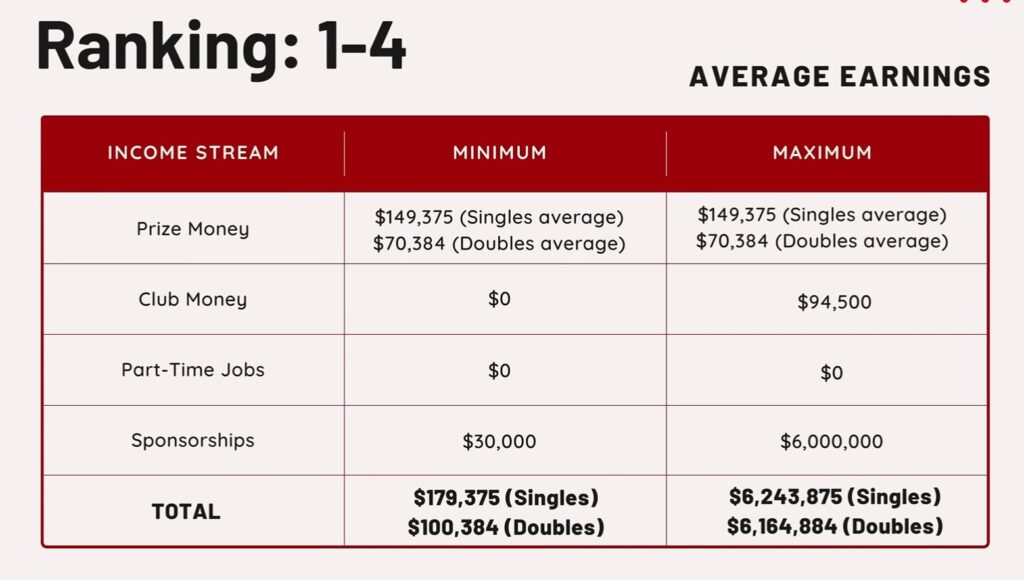
That’s not the full story though, because some players don’t get to keep much of their money, so let’s go through that now!
What Expenses Do Badminton Players Have?
Here’s a table showing the expenses different ranked badminton players would typically need to pay for:
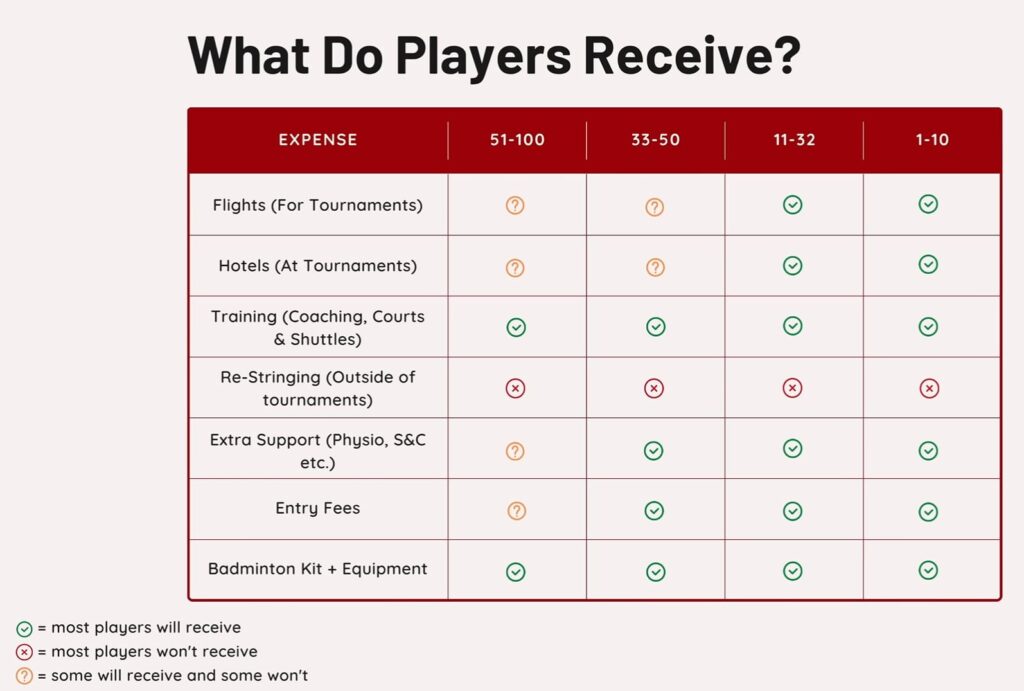
Do bear in mind that expenses can vary hugely between players – it depends on a number of factors.
A lot of players outside of the top 50 in the world will unlikely get much funding from their national associations – perhaps only a few tournaments covered each year. But as players get higher up the rankings, they’re more likely to receive more funding from their national association and even get a yearly salary, meaning they make more profit overall!
This will of course differ from country to country, and the costs will also differ depending on which hotels each player decides to stay in – and also if they like going out for fancy meals or not!!
To give you an idea of what tournaments cost in a year, here’s exactly what we each spent in 2022 being ranked 41 in the world playing a mix of higher and lower level tournaments:
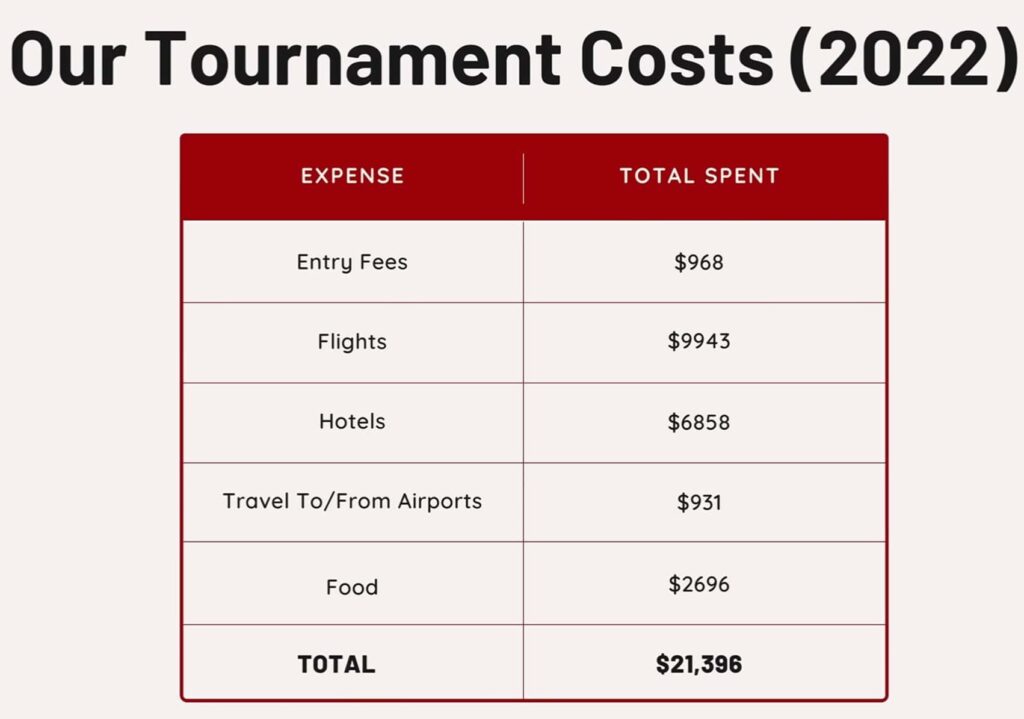
A huge thank you to our sponsors, Patreon members and any of you who have bought any of the resources on our website for helping us to fund these tournaments!
Other Considerations
For the income side of things, we should also mention about players creating their own brands too. Whilst this isn’t directly tied to their badminton, players are often able to market their brand to the audience they’ve gained through badminton!
For example, Viktor Axelsen created his own brand ‘VA Health’ which not only helps him earn more money and have something after his playing career has finished, but it also allows him to have something that takes his mind off badminton too! We discuss this more in our ‘Why Viktor Axelsen Is The Best Badminton Player In The World’ article here!
And from the expenses side of things, everything we discussed above does not include players basic living costs such as rent or food, which obviously takes up a significant portion of their expenses too.
Of course, there’s also tax which needs to be paid (unless you live in a tax free country), and also in some Asian countries players have to give a percentage of their prize money back to their association!
So there’s a lot of factors to consider when it comes to how much money a professional badminton player makes.
Overall, like any sport or job, badminton is well paid when you’re right at the top. However, this is only really the case if you’re in the top 10 or top 32 in the world.
Whilst some of these numbers do sound great, badminton is still quite far behind a lot of other sports. But we hope the money in the sport can continue to grow in the future as looking into the past if you won the All England in 2005 like our coach Nathan Robertson did, you only got $3500 each (1/10th of the 2022 prize money)!
We hope you found this interesting and also learned something new about a topic that probably not enough people talk about! If you’d like to see us chat through all of these figures and details too, you can check out our full YouTube video below!

